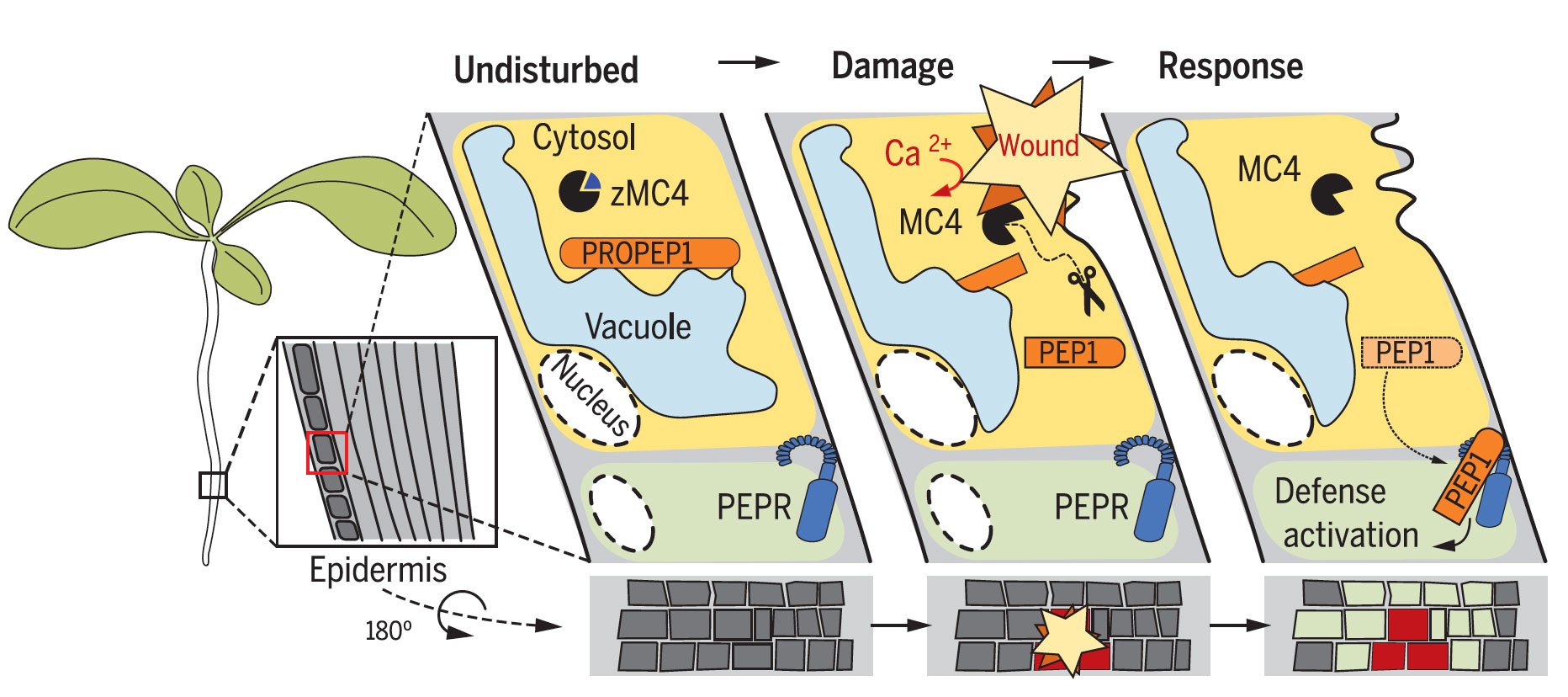博文
Science:植物激发子肽Pep产生、释放以及作用机制
||
Damage on plants activates Ca2+-dependent metacaspases for release of immunomodulatory peptides
First author: Tim Hander; Affiliations: University of Basel (巴塞尔大学): Basel, Switzerland
Corresponding author: Simon Stael
Introduction Cellular damage caused by wounding triggers signals to alert the surrounding tissue. As a universal process in all multicellular organisms, these signals activate the immune system to prevent infection and promote tissue regeneration, eventually leading to wound healing, but they have to be secured because aberrant immune stimulation can negatively affect health and growth. Plants, as sessile organisms, are regularly subject to chewing or sucking insects and physical damage inflicted by metazoans or exposure to the environment. In plants, short protein fragments or peptides can have immunomodulatory functions, such as those derived from the plant elicitor peptide (Pep) gene family. Peps are part of precursor proteins and have been proposed to act as wound signals that bind and activate the extracellular Pep receptors (PEPRs) to initiate an immune-like response. How Peps are produced and released upon wounding and how far this response extends from the harm site remain unclear.
由受伤导致的细胞损伤能够诱导改变周围组织的信号。作为多细胞生物中一个通用的生物学进程,这些信号会激活免疫系统以防止感染,并促进组织的再生,最终能够帮助伤口的愈合;但同时这些信号必需被严格控制,因为异常的免疫刺激对于个体的健康和生长具有负面效应。植物,作为固着生物,经常会受到咀嚼或吸食昆虫的啃食以及后生动物或暴露在开放环境中造成的物理损伤。在植物中,有一些短的蛋白片段或者多肽具有免疫调节的功能,比如说来自植物激发子肽Pep基因家族的成员。Pep是前体蛋白的一部分,被认为具有伤口信号的功能,能够结合并激活胞外Pep受体蛋白PEPRs,从而起始一个类似于免疫的响应。但是,植物在受伤时Pep是如何产生和释放的,以及该响应能够从受伤部位传递出去多远这些还不清楚。
Rationale Proteases can generate peptides from precursor proteins, but the genome of the model plant, Arabidopsis thaliana, encodes approximately 600 different proteases. To understand the molecular mechanisms that control the immune-activating signals, it is essential to identify the immune response-contributing proteases. Furthermore, wound formation has to be observed with great speed and precision to delineate the extent of the overall process. Pep1 was studied here as a representative member of the gene family.
蛋白酶可以利用前体蛋白产生多肽,但模式植物拟南芥的基因组共编码大约600个不同的蛋白酶。为了研究控制免疫激活信号的分子机制,作者必需首先鉴定到免疫响应的蛋白酶类。此外,作者还需要快速、高精度的观察伤口形成过程,以此了解该过程整个发生历程。作者在本文中主要研究Pep基因家族中的Pep1.
Results Pep1 generation was detected within 30 s after the injury, peaking at 5 min and lasting up to 1 hour in two wound model experiments on Arabidopsis seedlings: pinching with forceps or mechanical disruption of tissue integrity through grinding. Screening with various protease inhibitors revealed the involvement of metacaspases in Pep1 formation. Metacaspases are cysteine proteases, conserved in plants, fungi, protists, and bacteria that were historically named after caspases because of a certain degree of structural homology. However, they differ in activity and substrate specificity. Metacaspases require low-millimolar amounts of calcium (Ca2+) for in vitro activity and cleave their substrate proteins after the amino acids arginine and lysine. Physical damage activated the abundant METACASPASE4 (MC4) in both wound experiments. MC4 released Pep1 from its protein precursor PRECURSOR OF PEP1 (PROPEP1) by cleaving it behind a conserved arginine. A mutant lacking MC4 was unable to produce Pep1 in leaf tissue, whereas certain redundancy occurred with other metacaspase (or metacaspase-like) activities in root tissue. Inside the plant cell, PROPEP1 is attached to the cytosolic side of the vacuolar membrane. When undisturbed, cytosolic Ca2+ concentrations ([Ca2+]cyt) are too low to activate metacaspases that need unusually high [Ca2+] to function. When Arabidopsis root epidermis cells were damaged by means of multiphoton laser ablation, Pep1 release from the vacuolar membrane occurred only in the cytosol of directly hit cells, as observed with confocal microscopy. Loss of plasma membrane integrity in these cells led to a high and prolonged influx of extracellular [Ca2+] into the cytosol, sufficient to activate metacaspases, leading to the cleavage and release of Pep1 from PROPEP1. Application of exogenous PROPEP1 protein fragments, longer than the native Pep1, reduced root growth—a known negative effect of Pep1 overload—irrespective of MC4 cleavage. Accordingly, PROPEP1 cleavage to overcome retention of Pep1 at the vacuolar membrane seems more important than obtaining the mature Pep1 size.
作者通过用镊子夹或者利用研磨机械破坏组织完整性造成拟南芥的组织损伤,两次试验发现Pep1在组织受伤30秒后开始产生,并且在5分钟左右达到峰值,而后直到1小时后消失。作者通过各种蛋白酶抑制剂的筛选发现植物半胱氨酸蛋白酶metacaspases作用于Pep1的形成。Metacaspases属于半胱氨酸蛋白水解酶类,在植物、真菌、原生生物和细菌中十分保守,因为结构上的同源性被命名为半胱天冬氨酸蛋白酶(Caspases)。然而,Metacaspases与Caspases在活性和底物特异性方面还是存在差异的。Metacaspases需要低摩尔的钙离子能保证在体内的活性,并且在精氨酸和赖氨酸后面切割底物蛋白。在两次拟南芥损伤实验中,物理损伤均能够激活MC4的丰度。MC4能够剪切PEP1前体蛋白PROPEP1上保守的精氨酸,从而释放Pep1。MC4功能缺失突变体能够导致叶片组织中不能产生Pep1,而根组织中可能存在某些功能冗余的Metacaspases或者是Metacaspases-like。在植物细胞内,PROPEP1附着于液泡膜的细胞质一侧。在正常情况下,细胞质的钙离子浓度太低,不能激活Metacaspases,Metacaspases的激活通常需要较高的钙离子浓度来发挥功能。当拟南芥的根表皮细胞被多光子激光烧蚀损伤时,作者利用共聚焦显微镜观察到仅仅在受损细胞的细胞质中Pep1能够从液泡膜上释放。这些细胞中质膜完整性的破坏会导致细胞外大量的钙离子进入到细胞质中,从而激活Metacaspases,进一步导致PROPEP1的剪切和Pep1的释放。施用比天然Pep1更长的外源性PROPEP1蛋白片段能够减慢根的生长,该效应是典型的Pep1过载后的负面影响,与MC4的剪切无关。因此,PROPEP1的剪切来维持Pep1的含量似乎要比获得成熟片段大小的Pep1更加重要。
Plants exploit highly conserved mechanisms—such as Ca2+-partitioning across intact membranes and maturation of immunomodulatory peptides by proteases—to rapidly trigger defense responses against tissue damage. Pep1 is released by activation of MC4 upon prolonged high levels of [Ca2+]cyt that occur only in directly damaged cells, and this response is safeguarded by subcellular retention of PROPEP1 at the vacuolar membrane in the absence of damage. Metacaspases, together with Peps and PEPRs, now emerge as potential targets for breeding and improving crop immunity.
植物存在高度保守的机制,比如完整膜上钙离子的分隔以及蛋白酶促进免疫调节肽的成熟等,从而针对组织损伤快速诱导防御响应。直接受到损伤的细胞中会存在高水平的钙离子浓度,进而MC4被激活,促进前体蛋白PROPEP1释放Pep1,而在未受伤的细胞中由于PROPEP1附着于液泡膜上而不会触发该响应。因此,Metacaspases与Peps、PEPRs一起可作为作物免疫育种和遗传改良的潜在靶基因。
通讯:Simon Stael(https://plantandmicrobiology.berkeley.edu/profile/luan)
研究方向:研究Metacaspases的底物蛋白,理解植物在病原侵染时的细胞程序性死亡的调控机制。
doi: 10.1126/science.aar7486
Journal: Science
Published date: March 22, 2019
https://blog.sciencenet.cn/blog-3158122-1181279.html
上一篇:Plant Cell:拟南芥植物激发子肽Pep作用于根的生长抑制
下一篇:Cell:拟南芥与碎米芥叶片形态差异的生长框架
全部作者的其他最新博文
- • Plant Physiology:CsMADS3促进柑果中的叶绿素降解和类胡萝卜素合成(华中农业大学)
- • Molecular Plant:LBD11-ROS反馈调节作用于拟南芥的维管形成层增殖和次生生长(浦项科技大学)
- • Science Advances:根结线虫通过调控植物的CLE3-CLV1模块,促进侵染进程(日本熊本大学)
- • Nature Communications:油菜素内酯参与植物营养生长期转变的分子机制解析(浙江农林大学)
- • Current Biology:光合作用产生的蔗糖驱动侧根“生物钟”(德国弗莱堡大学)
- • PNAS:花同源异型基因在叶中被抑制、花中被激活的分子机制(南卡罗来纳大学)

